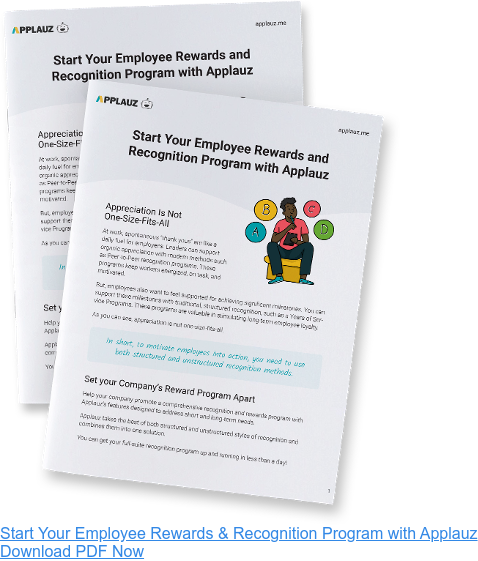As an HR professional, planning and launching a recognition program is a big task. You want what most other companies want--to launch the best employee recognition program for your organization. But once your company’s recognition program is ready to be rolled out, you and your HR team will start doing a different type of work -- program admin and management.
Note that there are different types of recognition programs. In this article, we refer to a digital Peer-to-Peer style program: one that involves spontaneous forms of recognition such as Applauz.
Rolling out your recognition program
At this stage, you might be asking yourself -- how will the company respond to the rollout? Will managers even use it? And maybe more important questions, like, will it have an impact?
All these questions are normal; you’ve invested a lot of time and energy to get the program to where it is now. The next step for HR is to take action to ensure the entire company gets involved too.
Remember: As a program administrator, a lot is in your control. As such, you can take steps to ensure that the program not only launches smoothly but is a success!
Small steps equal big wins
That said, many of the best practices of a successful recognition program are simple and straightforward. Still, this requires time and dedication. In other words, carving out time to prioritize the steps below will contribute to the program's overall success.
Let's dive a little deeper. By the end of this article, you will better understand what it takes to launch and run your company's program.
Dos and Don’ts of Managing a Recognition Program
DO over-communicate during the launch of your program
As an HR professional, you're likely familiar with the reality of HR emails conveniently getting "lost" in people's inboxes. That's why for a recognition program rollout, it's advised HR always over-communicate.
In practice, this involves sending out more than just one email to announce the program. Depending on your business's size, it can also entail making an in-person announcement to the entire company. Or, at the very least, ensuring that managers are communicating the news face-to-face to their teams. Bottom line: At least one in-person announcement is crucial.
program. Depending on your business's size, it can also entail making an in-person announcement to the entire company. Or, at the very least, ensuring that managers are communicating the news face-to-face to their teams. Bottom line: At least one in-person announcement is crucial.
It can take a little bit of encouragement to get people involved in the program in the early days, so simply making one announcement via email is not enough. Planning to over-communicate is always best practice to make sure the news sticks and is at the forefront of everyone's mind.
DO plan for direct communication with department managers
Managers are the people who initiate recognition and encourage their team members to also get involved. They are the champions of your company's new recognition program. As such, department managers will play a critical part in promoting the program and ensuring its success.
This is why all the initial communication should be tailored for department managers. This means a separate announcement email should be written just for them. This way, they can clearly understand their distinct responsibilities within the program.
Don't only make one generic company-wide announcement. Managers should understand the importance of their role and how their efforts will be critical to the program's success.
Pro Tip: Not sure what to write when addressing managers? We drafted a recognition program announcement email template (one for managers and one for employees) to help get you started!
Dont forget to give concrete "next steps" and nudge employees in the right direction
Receiving a program launch announcement email from HR is important. Still, the email should go further than simply announcing the launch. To maximize the adoption rate, make sure to nudge people in the right direction. People need to know why this is important for your business and the next steps.
We recommend you always include some very actionable and concrete "next steps" in your announcement email and other follow-up communications in relation to the program.
Include some of these essential points in your communication to "nudge" employees in the right direction:
- Why this initiative is important to your business: Explain what the goal of the program is. Tell people what they can expect to achieve from participating.
- What are the next steps: Should they log into the platform, upload a profile picture, or write a recognition message, etc.
- Point them to resources: Point your employees towards external resources like the Applauz blogs or articles about recognition.
If you explain clearly what they need to do next, they are more likely to take the action you want.
DO set managers up for success by giving them a quick “tutorial”
Technology and digital tools often support modern-day recognition programs. For example, Applauz is web-based platform employees log into to offer each other recognition.
These tools are usually user-friendly and don’t require people to be ultra tech-savvy. Yet, using a new tool can always be intimidating to some people. As such, if your recognition program involves a digital app or platform. In that case, you should give program managers a quick review of how it works.
managers a quick review of how it works.
The worse thing you can do is send out invitations to log into a new tool without any warning or direction. If you are working remotely, you can complete a quick meeting in 30-minute with a screen-sharing presentation. All it takes is a brief initial exposure to remove any barriers. Ultimately, this meeting will help address any unnecessary worries or concerns. As a result, department managers will be in a position to start recognizing employees as quickly as possible!
DO monitor the program’s adoption statistics
Most recognition platforms include features that enable administrators to have a birds-eye view of participation data. This means you can get a concrete picture of how many employees are participating and at what rate.
By looking at this information, you'll be able to assess whether your HR communications and rollout efforts are yielding results.
On the other hand, if you roll out your recognition program and don't keep an eye on participation data, you will not understand if your company's employees are actually using the program or maximizing its value.
Bottom line: in the early stages of the rollout, keeping an eye on basic data is critical to the long-term success of the program.
Pro Tip: If you're unsure of which statistics to focus on, check out our short guide on understanding the health of your Applauz program.
Dont forget to periodically meet with department managers to check-in
To that end, statistics on a screen are essential, but they don't tell the entire story. That's why in the early days of a new program, it's crucial to meet face-to-face with company managers as well. The meetings can be very brief; the goal is to gather feedback and keep the new program at the forefront of everyone's mind.
As mentioned before, some people may be hesitant to take part -- giving recognition and appreciation at work is a soft skill some people need help with! In other words, some people might be shyer than others.
This is why meeting with managers is essential. HR can help managers devise helpful strategies to get maximum employee participation. These efforts will go a long way to help to boost the program's success.
DO offer managers direction on how to give great recognition
There's a big difference between saying "good job" while walking out the door and taking the time to describe the things you value about an employee. As such, a significant barrier to a recognition program's success is not the quantity of recognition given but rather the quality.
Pro Tip: Not sure what great recognition looks like? Use this article on giving powerful recognition as a recognition “cheat sheet” you can give to managers.
Bottom line: Managers must learn how to personalize recognition. In other words, a recognition message should not only say "good job." But it should also include words that express why the employee stands out. Essentially answering the question: how does that employee add value to the team or company.
Also, recognition shouldn't always be performance-driven. It's important to highlight work accomplishments, yes -- but for a recognition program to emotionally resonate with employees, managers should also express appreciation for soft skills too.
DO encourage recognition to be given regularly
The main benefit of Peer-to-Peer recognition is that appreciation can be given anytime. In other words, employees don't have to wait impatiently for a formal review to get positive feedback from their manager. Both managers and coworkers can give appreciation with visibility and frequency.
However, offering regular recognition (in an informal context) may feel new to many people. In short, they might be unsure how often to give praise.
While there is no such thing as giving too much recognition, it's always advisable to focus on quality instead of quantity. In other words, sporadically writing a sincere, heartfelt message is more beneficial than a hollow one to say you did it.
To get managers accustomed to giving recognition regularly, set them up with a feasible goal. Ideally, managers should aim to recognize at least half their team once per month.
Remember, giving recognition is not time-consuming. It can take just a few minutes to write a message that is genuine and sincere.
Pro Tip: If managers aren't sure what to write, here are a few recognition message examples to get them started. Remember, for the most impact; they should add a few words to make the message feel personal.
Do understand the factors that can negatively impact a program
Some recognition programs fail to reach their full potential as they confront common problems -- such as halfhearted recognition efforts from managers. Educate yourself about the issues that can impact a program. Your HR team will be better positioned to avoid and resolve them if they do come up.
Pro Tip: Reading the book The Vibrant Workplace is a great place to start. We have written a summary of the book here for our quarterly book club series.
A critical factor to remember: The primary goal of a program should be to increase the frequency of appreciation and recognition in the workplace. In other words, your company began the program with the employees' wellbeing and happiness as the number one goal.
Being aware of this factor will help you better articulate the program's true goals in your launch communication. As a result, when HR delivers this message correctly to employees, positioning the program as a perk intended for their benefit, greater engagement and productivity will occur naturally.
Final Thoughts
No one can argue against the importance of employee recognition in the workplace. Yet, it can still take some effort to get people involved.
That said, once everyone is in the habit of giving regular recognition, it will become second nature. Typically, administrator involvement will start to decline with time.
Ultimately, following the steps above will help HR and your company's employees get started on the right track. You'll be in a position to maximize the full value of your program, and your company executives will benefit from greater employee morale and engagement as a result.
About the author
 Michelle Cadieux
Michelle Cadieux
Michelle is a content writer for Applauz. She holds a Bachelor's degree in Psychology from Concordia University, and she has been writing about work and employee happiness for over five years.


